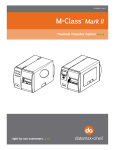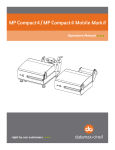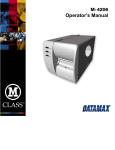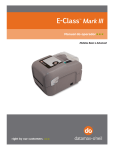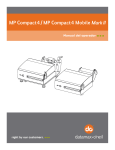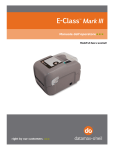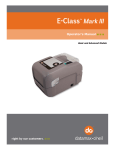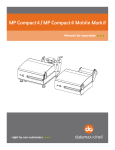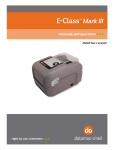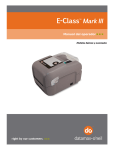Download Datalogic Scanning M8300 Barcode Reader User Manual
Transcript
Printer Overview Congratulations on your purchase of the Ex2 printer. The Ex2 hereafter referred to as ‘the printer’, blends quality and durability into an affordable package with state-of-the-art electronics and user-friendly features to redefine the standard in thermal printers. The printer uses a unique one button design to simplify operation, while its USB, RS232 serial, and parallel interfaces allow easy connection to your host system. This manual provides all the information necessary to operate the printer. To print labels or tags simply refer to the instructions included with the software you have chosen to create the labels. A Windows® printer driver can be found on our website (www.datamaxcorp.com) or on the included CDROM. If you wish to write a custom program, a copy of the 'Class Series Programmer’s Manual' can also be found on the CD-ROM. 1 Printer Connections Connecting Power The printer is powered by an external power supply that connects as shown. Connect the power cord to the printer first and then plug the other end into a suitable AC outlet. Use only the power supply shipped with the printer. 2 Interface Connection The printer can be connected to the host via a USB, serial or parallel cable. The Printer will automatically connect to the first port (USB, serial or parallel) that transmits valid data. After this connection has been made, the printer’s power must be cycled Off and On to change the interface connection. USB Connection: The USB Interface is supported in Windows 95 and greater. Depending upon the operating system of your host computer, installation may differ slightly. Parallel Connection: The parallel interface requires a standard parallel cable with a 36 pin male connector. 3 Serial Connection: The serial interface supports RS-232C communications via a DB-9 connector. The following list of serial port settings is menuselectable and must match the host computer’s serial port settings: > Baud Rate (Default 9600 bps) > Word Length (Default 8 bits) In addition to the port settings, the serial interface cable wiring must have specific connections (pin-outs) for proper data exchange between the host and printer. The different serial cable pin-outs and part numbers are shown below (contact your reseller for ordering information). An "off the shelf" serial cable can be used with Xon/Xoff handshaking. Optional Internal Ethernet: When using this interface, refer to the Ethernet Setup section, for proper setup, and configuration. 4 Ethernet Setup The printer must be assigned and IP address in order to communicate withe the host/network. This can be accomplished using several methods: • • • Automatically obtain an IP via a DHCP Server Using the Printer Configuration Utility (DMXConfig) to set IP values Using the default IP, configure settings via the printer's internal web pages Automatically Obtain an IP via a DHCP Server The printer is factory configured to "DHCP Enabled". When the printer is powered on it will search for a DHCP server, if found, the server will assign an IP address to the printer. Connect the network cable to the printer and power on the printer. Allow 90 seconds (from power up) for the printer to retrieve an IP address from the server. After this time, print a Configuration Label to verify the printers current network settings. To print the Configuration Label: 1. Be sure the printer is properly loaded with media (at least 2 inches wide), and that the power to the printer is off. 2. Apply power to the printer, once the Status light is on press and hold the Control Button. 3. Continue to hold the Control Button until the Configuration Label starts to print. Note: After the printer has completed printing the Configuration Label the printer will enter Hex Dump Mode. To exit Hex Dump Mode simply remove power from the printer or perform a 'Printer Reset' by holding the Control Button for at least 10 seconds, then releasing. 5 The 'NIC ADAPTER' section on the Configuration Label will list the printer's current network settings. After 90 seconds if a DHCP server is not found the printer will fall back to its default network settings of: IP Address: 192.168.10.2 Subnet Mask: 255.255.255.0 Gateway: 0.0.0.0 If the DHCP retrieval was successful, a new IP address value should be shown. This IP address can then be used to browse to the printer's internal web pages for further configuration or used for installing the Windows Driver. Using the Printer Configuration Utility (DMXConfig) to set IP values 1. Connect the printer to the host via the parallel or serial port 2. Start the DMXConfig program, see the Printer Configuration Utility section for installation. 3. Click “Query Printer” Button – This will retrieve the printer's current configuration. 6 4. Click on the “Communications” Tab, scroll to bottom for IP settings. 5. Set the IP, Mask, Gateway to your desired values. 6. Click the ‘Configure Printer” button to send the changed values to the printer. 7. Go to “User Functions” Tab and click the “Print Configuration” Button to confirm the printer has received the new values. 8. Exit the DMXConfig program. 9. Power Off the printer and remove the parallel or serial connection. Connect the network cable to the printer and power on the printer. The new IP address can then be used to browse to the printer's internal web pages for further configuration or used for installing the Windows Driver. 7 Configure Settings via The Printer's Internal Web Pages The printer is factory configured to the default network settings of: IP Address: 192.168.10.2 Subnet Mask: 255.255.255.0 Gateway: 0.0.0.0 If these values are in range of your network, (if you are unsure contact your system administrator), you can browse directly to the printer's internal web pages by entering this IP address into a web browser. 1. Connect the network cable to the printer and power on the printer. 2. Open a web browser such as "Internet Explorer". Type the default IP address (192.168.10.2). The printer's internal web pages should appear: 8 3. Click on the "TCP/IP Configuration" tab. 4. Set the IP, Mask, Gateway and other network settings to your desired values. 5. Type the Authentication password (sysadm) into the box on the bottom of the page and click on "Apply" to apply the changes. The new IP address can then be used to browse to the printer's internal web pages for further configuration or used for installing the Windows Driver. 9 Loading Media Installing the Media Roll Note: The Media Guides must be adjusted to match the width of the media you are using, (see Media Guide Adjustment). Once the Media Guides are set for the width of the media being used it is no longer necessary to perform this adjustment. Note: It is important that the Windows Printer Driver 'Stock' setting matches the size of the label you are using. See the Windows Driver section. 1. Slide the Media Hanger Guides outwards until they lock in place. 2. Insert the roll of Media as shown. Gently push the left Media Hanger Guide toward the rear of the printer so that it releases from the Catch. The Guides will then retract and grasp the media roll. 10 3. Feed the media forward into the printer. Once the media is detected the printer will grab the media and position it for printing. 11 Loading the Peel and Present Option Note: The Present Sensor can be used with the tear bar instead of using the peel feature. For this configuration simply complete steps 1 and 2 only. 1. Open the Peel and Present Door. Set the Peel and Present switch to the '1' position. 2. Complete the 'standard' media loading as described in the previous section. 3. Feed approximately 12 inches of media out of the printer and remove the labels from the media liner. 4. Route the media liner over the Peel Bar, behind the Rollers, and out of the opening beneath the Peel and Present Door as shown. 12 5. While pulling firmly on the Media Liner, close the Peel and Present Door. It is important to keep the Media Liner taught around the Peel Bar. 13 Fan-fold / External Supply Loading With the Media Hanger Guides in their centered position, route the media through the Slot in the Cover, over the Hanger Guides, and into the properly adjusted media guides. 14 Media Setup The printer's default setup is for die-cut label media, 4” (101.6mm) wide. Reflective label media (black mark) and Continuous label media (no black mark, holes, gaps etc.) may be used by configuring the printer appropriately using the Windows Printer Driver or Printer Configuration Utility (DMXConfig), both provided on the Accessories CD. Consult the help files found in these programs for additional information. Continuous Label Media Media Setup – Windows Printer Driver: Driver setup is required for any software application that uses the Windows Printer Driver. This setup only provides the printer with dynamic settings that are lost when power is removed. Step 1 Action Printer driver setup 2 Load labels 3 Create label format 4 5 Print the label Press the Control Button Comments Printing Preferences from the General tab on the driver provides the proper controls to setup for the desired label media. From there, the Page Setup tab must be selected to specify the label size, width and length. The Stock tab is where the label type is controlled. Media Control, Label Sensor, provides appropriate selections for the label type in use. Select Label Sensor Disabled for continuous label media. Loading continuous labels will, depending on its reflectance levels, may result in a Top of Form fault. This is normal; printer drivers do not configure the printer until a label is sent to be printed. Using any Windows application, create a label format. Ensure that the page size selected in the application software is the same as that configured in the printer driver. The printer will continue to flash the Status Light indicating a fault. This will clear the fault, feeding the selected label length, and then print the label. On subsequent printer power-ups, if the media has not been removed, simply print the label as outlined in steps 3 and 4. Note: To configure the printers "power-up" settings use the Printer Configuration Utility (DMXConfig) included on the Accessories CD-ROM. Using this method will result in less label waste when loading continuous label media 15 Reflective Mark Label Media Media Setup – Windows Printer Driver: Driver setup is required for any software application that uses the Windows Printer Driver. This setup only provides the printer with dynamic settings that are lost when power is removed. Step 1 Action Printer driver setup 2 Load labels 3 Create label format 4 5 Print the label Press the Control Button Comments Printing Preferences from the General tab on the driver provides the proper controls to setup for the desired label media. From there, the Page Setup tab must be selected to specify the label size, width and length. The Stock tab is where the label type is controlled. Media Control, Label Sensor, provides appropriate selections for the label type in use. Select Label Sensor 'Label Mark' for reflective label media. Loading reflective label media will, depending on its reflectance levels, may result in a Top of Form fault. This is normal; printer drivers do not configure the printer until a label is sent to be printed. Using any Windows application, create a label format. Ensure that the page size selected in the application software is the same as that configured in the printer driver. The printer will continue to flash the Status Light indicating a fault. This will clear the fault, feeding the selected label length, and then print the label. On subsequent printer power-ups, if the media has not been removed, simply print the label as outlined in steps 3 and 4. Note: To configure the printers "power-up" settings use the Printer Configuration Utility (DMXConfig) included on the Accessories CD-ROM. Using this method will result in less label waste when loading continuous label media 16 Printer Operation The printer is equipped with a single multi-function Control Button and Status Light. Status Light 'On' (Normal Operation) With the status light in the ON state the control button will function as follows: Printer at Idle - Printer feeds media to the next label. Printing Labels - Pauses Printer, press again to resume. Status Light 'Flashing' (Paused or Error Condition) The status light flashing indicates that operator attention is required. In this state the control button will function as follows: Printer is Paused - Printer resumes normal operation; - Press and hold for 3 seconds to cancel current print job. Error Mode - Clears error, feeds media to next label and resumes operation. Printer Reset The printer can be reset by pressing and holding the Control Button for at least 10 seconds, then release the button, the Status Light will turn off momentarily. Resetting the printer will clear RAM of downloaded images, fonts, label formats, and remove temporary printer configuration changes. 17 Maintenance Mode Initiation of this mode causes the printer to print its Configuration Label and to begin the Hex Dump Mode. The Configuration Label provides valuable printer information including the firmware version, memory allocations, enabled options, communications settings, and label-counter data. To print the Configuration Label: 1. Be sure the printer is properly loaded with media (at least 4 inches wide), and that the power to the printer is off. 2. Apply power to the printer, once the Status light is on press and hold the Control Button. 3. Continue to hold the Control Button until the Configuration Label starts to print. After the printer has completed printing the Configuration Label the printer will enter Hex Dump Mode. In this mode, all data sent to the printer will be immediately output in hexadecimal code, along with the printable ASCII equivalents. The Hex Dump Mode is a useful tool for advanced users in the diagnosis of problems including communications, handshaking, and DPL syntax errors. To decode this information, the Programmer’s Manual is an essential reference. To exit Hex Dump Mode simply remove power from the printer or perform a 'Printer Reset' by holding the Control Button for at least 10 seconds, then releasing. 18 Windows Driver The Windows driver is located on the Accessories CD-Rom included with your printer. For the latest version please visit our web site at www.datamaxcorp.com. Installing the Windows Driver: Place the Accessories CD-Rom included with your printer into your computers CD-Rom drive. Once the CD-Rom starts, select "Windows Printer Drivers" from the main menu and then click the "Install" button. The Windows "Add Printer Wizard" will begin. Follow the steps in the wizard to complete the driver installation. When prompted for the driver file, select 'Have Disk' and browse to the following file on the CD-Rom: Windows 95, 98, ME, 2000, and XP: "D:\DRIVERS\Seagull\Datamax for 95, 98, me, 2000, and xp.inf" (Where D: is your CD-Rom drive) Windows NT4.0: "D:\DRIVERS\Seagull\NT4\Datamax for nt 4.0 only.inf" (Where D: is your CD-Rom drive) 19 Important Notes: The Windows driver functions the same as any other Windows printer. A built in help file is available for complete information on all settings, however there are some important settings that should be observed for trouble free printing. Page Setup Tab: Stock It is important that the Stock setting matches the size of the label you are using. If you cannot find a match for your label click 'New' and enter the dimensions of your label. Options Tab: Print Speed & Printhead Temperature These two settings will have the greatest effect on print quality. Some label stocks will require more heat and slower print speeds to generate a quality image. The Windows application software used to create the label format will likely have a "Page Setup" screen. This will also need to match the size of the label you are using. 20 Printer Configuration Utility (DMXConfig) DMXConfig (located on the Accessories CD-ROM) is a windows based configuration utility that allows the user to make changes to the existing printer setup via a direct connection to the host computers serial and parallel connection or any port (USB, Ethernet, ect.) assigned to a Datamax printer driver port. DMXConfig Features: > Allows Real-Time Control/Query of Printer Configuration > Define and Save Optimal Configurations for Applications > Saved Configurations can be Shared with other Printers and Sent via Email > Download Files, Formats and Fonts > Query Memory Modules Note: Be sure to use the DMXConfig utility located on the Accessories CD-Rom that is included with your printer. Older versions might not operate correctly with some printers. For the latest version please visit our web site at www.datamaxcorp.com. Installing DMXConfig: Place the Accessories CD-Rom included with your printer into your computers CD-Rom drive. Once the CD-Rom starts, select "Printer Configuration Utility" from the main menu and then click the "Install" button. The DMXConfig setup program will begin. Follow the steps to complete the program installation. 21 Maintenance and Adjustments Cleaning Intervals The following table outlines the recommended maintenance schedule for the various printer parts. Area Printhead Platen Roller Peel-Off Rollers Media Path Peel/Tear Bar Media Sensor Exterior Interior Method Turn off the printer before cleaning the printhead. Use solvent* on a cotton swab to clean the printhead from end to end. Turn the power off. Remove the platen roller and clean it thoroughly with solvent* and a cotton swab. Rotate the peel-off rollers and clean it thoroughly with solvent* and a cotton swab. Solvent* Solvent* Compressed Air Mild detergent or desktop cleaner. Brush or vacuum Interval After every roll of media. After every roll of media. After every roll of media. After every roll of media. As needed Monthly As needed As needed. * It is recommended that a solvent containing isopropyl alcohol be used. Isopropyl alcohol is a flammable solvent, always take the proper precautions when using this substance. 22 Printhead Cleaning If print quality declines (symptoms include non-compliant bar codes, print dropouts, streaks), the typical cause is debris build-up on the printhead. Furthermore, when the build-up is not removed it may lead to element failure, greatly reducing the life of the printhead. To clean the printhead: 1. Unplug the printer. 2. Open the cover. Press down on the Printhead Latches and raise the Printhead Carrier. Allow the printhead to cool before proceeding. 3. Using a Cotton Swab moistened, not soaked, with isopropyl alcohol gently wipe away any build-up on the printhead surface, paying close attention to the Burn Line. Allow the printhead to dry. 4. Lower the Printhead Carrier back to the down and locked position. 5. Close the cover. Plug in the printer. Feed several labels to normalize tracking. 23 Printhead Pressure Adjustment To accommodate a variety of media types, the pressure applied by the printhead assembly is adjustable. This pressure is factory set to work with most media types, so this adjustment should only be performed after attempting to improve print quality through the use of the (1) heat and/or (2) print speed software controls. When adjusting, use only the minimum pressure necessary for better imaging. To adjust: 1. Load the printer with media, see 'Loading Media'. 2. Print a test label from the host. 3. Using a small coin or screwdriver, turn the Printhead Pressure Adjustment Screw so the arrows point to the desired setting: Low Medium High Note: Excessive pressure can reduce the service life of the printhead and platen roller. 24 Media Guide Adjustment Note: It is important that the Windows print driver 'Stock' setting matches the size of the label you are using. See the Windows Driver section. 1. Unplug the printer from its power source. 2. Press down on both Printhead Latches to unlock the Printhead Carrier. Raise the Printhead Carrier to its up position. 3. Adjust the Media Guides to fit the width of your media. The guides should be positioned so that there is very little side-to-side media movement, but not so tight as to cause friction or bowing of the media. 25 Too Tight Correct Too Loose 4. Close and latch the Printhead Carrier. The printer is now ready to be loaded with media, (see Loading Media) 26



























